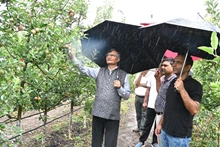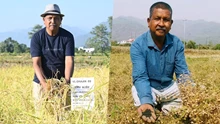
Safflower (Carthamus tinctorius) is a versatile crop known for its oil-rich seeds, which are high in linoleic acid, an essential fatty acid that may help reduce heart disease risk, prevent blood clots, dilate blood vessels, lower blood pressure, and stimulate heart function. Its medicinal flowers can boost energy, soothe, and regulate menstrual flow. They contain hydroxysafflor yellow A, an antioxidant that protects cells from oxidative stress but may act as a laxative in excess. In India, Maharashtra, Karnataka, and Telangana are the main safflower-growing states, with some cultivation in Madhya Pradesh and Chhattisgarh. Safflower is mainly self-pollinated, but some cross-pollination occurs via honeybees.
Climate and Soil
-
Safflower thrives in cool seasons with an optimal germination temperature of 15.5°C. Seedlings tolerate low temperatures, while the ideal range for flowering and high seed yield is 24-32°C. Excessive rainfall or humidity can increase fungal diseases.
-
The crop requires heavy soils with good drainage. While slightly alkaline soils are acceptable, acidic soils should be avoided to ensure optimal growth and yield.
Land Preparation
To prepare the land for safflower cultivation, deep ploughing during the summer is essential. This should be followed by 2-3 harrowing during the Kharif season for fallows or two harrowing after harvesting a Kharif pulse crop.
Varieties
-
Manjira: Matures in 115-120 days with a yield of 3-4 quintals per acre. It has yellow flowers that turn orange, containing 27-30% oil.
-
Sagaramutyalu: Takes 115-125 days to mature, yielding 5-4 quintals per acre. It features yellow flowers and 27-32% oil content, along with rust resistance.
-
DSH-129: Requires 130 days to mature, yielding 7 quintals per acre. It is wilt tolerant with 32% oil content.
-
TSF-1: Matures in 120 days, with a yield of 6-8 quintals per acre. It is resistant to wilt and has an oil content of 31%.
Sowing Time
Safflower should be sown between the second fortnight of September and the first fortnight of October.
Seed Rate and Sowing Method
For a sole crop, use 4 kg of seed per acre. If intercropping with Bengal gram or coriander in a 1:2 ratio, use 1.5 kg of seed per acre. Seeds can be sown behind a plough or with a drill at a depth of 5 cm, maintaining a spacing of 45 x 20 cm.
Seed Treatment
Before sowing, treat seeds with 3 g of Captan or 1 g of Carbendazim per kg of seed to protect against fungal diseases.
Nutrient Management
Apply 16 kg of nitrogen (N) and 10 kg of phosphorus (P) per acre, preferably in the form of single super phosphate (SSP). Initially, use 20-25 kg of urea and 60-65 kg of SSP as basal application. Follow up with an additional 15-20 kg of urea at 40-45 days after sowing (DAS).
Weed Management
It is crucial to keep the crop relatively weed-free until 20-25 DAS. Perform harrowing between rows at 25 and 45-50 DAS to remove weeds and conserve moisture. Additionally, pre-emergence spraying with Alachlor 50% or Pendimithalin 30% at 1 liter per acre one day after sowing can help manage weeds.
Water Management
In light soils, 1-2 irrigations are necessary. Provide one life-saving irrigation at 30-35 DAS or 65-75 DAS to ensure the crop's survival during critical growth stages.
Plant Protection
Insect Management:
-
For leaf-eating caterpillars, spray with Quinalphos at 2 ml/l or Chlorpyriphos at 2.5 ml/l of water.
-
To control aphids, especially in late-sown crops, spray Dimethoate (2 ml/l), Monocrotophos (1.6 ml/l), or Chlorpyriphos (2.5 ml/l).
Disease Management:
-
Alternaria Leaf Spot: Spray Mancozeb at 2.5 g/l of water twice at a 7-10 day interval.
-
Fusarium Wilt: Implement crop rotation with chickpea and grow-resistant varieties like TSF-1, NARI, and SH-1. Treat seeds with Carbendazim at 1 g/kg.
Parrot Damage:
Parrots can cause severe damage, especially in small, discrete holdings. Scaring parrots in the morning and evening during the seed-filling stage is necessary.
Harvesting and Storage
Harvesting safflower in the morning helps prevent seed shedding and ensures the spines are soft. Threshing can be done using a tractor or by beating with sticks. Store seeds with a moisture content of 5-8%. Additionally, harvesting petals 15-20 days after flowering can provide a source for herbal tea.
Uses
-
Safflower has been used as an adulterant for saffron.
-
Its primary modern use is for its oil, which doesn't yellow with age, making it ideal for varnishes and paints.
-
Most safflower oil is used in soft margarines, salad oil, and cooking oil due to its high polyunsaturated fat content.
-
The leftover meal is used as a protein supplement for livestock.












